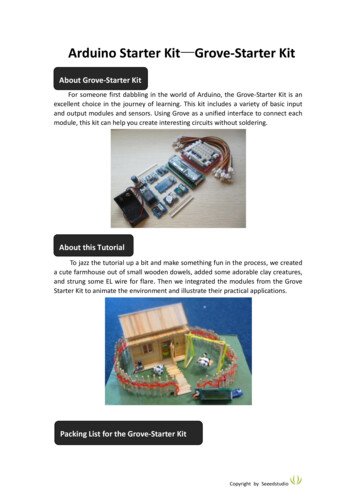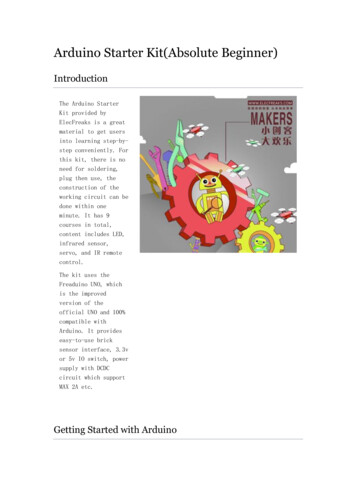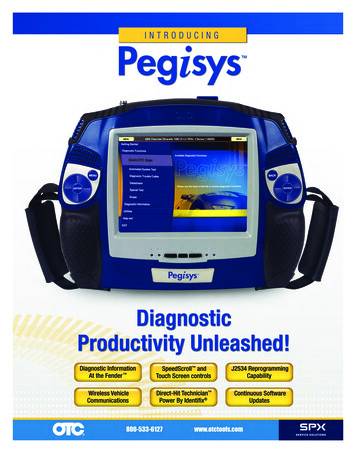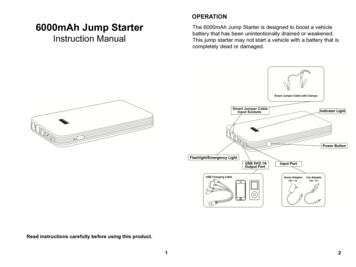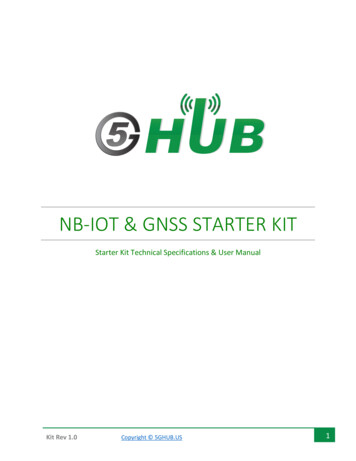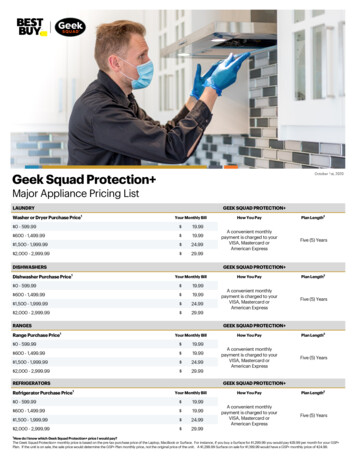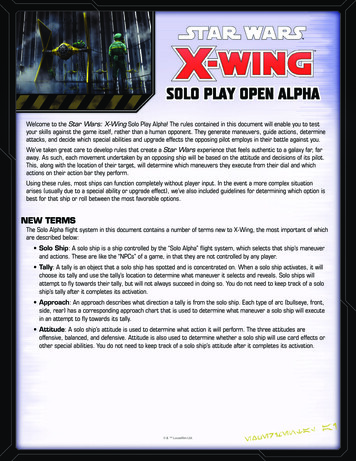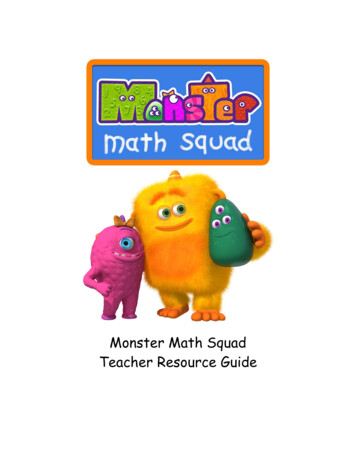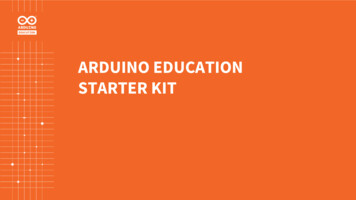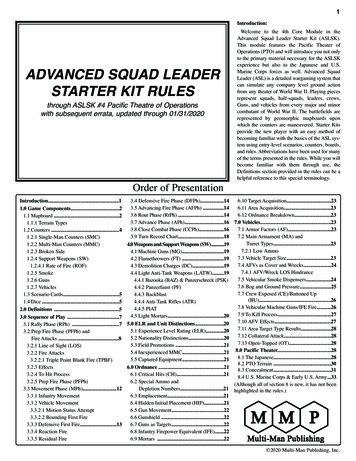
Transcription
1Introduction:ADVANCED SQUAD LEADERSTARTER KIT RULESthrough ASLSK #4 Pacific Theatre of Operationswith subsequent errata, updated through 01/31/2020Welcome to the 4th Core Module in theAdvanced Squad Leader Starter Kit (ASLSK).This module features the Pacific Theater ofOperations (PTO) and will introduce you not onlyto the primary material necessary for the ASLSKexperience but also to the Japanese and U.S.Marine Corps forces as well. Advanced SquadLeader (ASL) is a detailed wargaming system thatcan simulate any company level ground actionfrom any theater of World War II. Playing piecesrepresent squads, half-squads, leaders, crews,Guns, and vehicles from every major and minorcombatant of World War II. The battlefields arerepresented by geomorphic mapboards uponwhich the counters are maneuvered. Starter Kitsprovide the new player with an easy method ofbecoming familiar with the basics of the ASL system using entry-level scenarios, counters, boards,and rules. Abbreviations have been used for manyof the terms presented in the rules. While you willbecome familiar with them through use, theDefinitions section provided in the rules can be ahelpful reference to this special terminology.Order of PresentationIntroduction.13.4 Defensive Fire Phase (DFPh).146.10 Target Acquisition.233.5 Advancing Fire Phase (AFPh) .146.11 Area Acquisition.231.0 Game Components.23.6 Rout Phase (RtPh) .146.12 Ordnance Breakdown.231.1 Mapboard .23.7 Advance Phase (APh).16 7.0 Vehicles.231.1.1 Terrain Types3.8 Close Combat Phase (CCPh).167.1 Armor Factors (AF).231.2 Counters .43.9 Turn Record Chart.187.2 Main Armament (MA) and1.2.1 Single-Man Counters (SMC)Turret Types.231.2.2 Multi-Man Counters (MMC)4.0 Weapons and Support Weapons (SW).197.2.1 Low Ammo1.2.3 Broken Side4.1 Machine Guns (MG).197.3 Vehicle Target Size.231.2.4 Support Weapons (SW)4.2 Flamethrowers (FT) .197.4 AFVs as Cover and Wrecks.241.2.4.1 Rate of Fire (ROF)4.3 Demolition Charges (DC).197.4.1 AFV/Wreck LOS Hindrance1.2.5 Smoke4.4 Light Anti-Tank Weapons (LATW).197.5Vehicular Smoke Dispensers.241.2.6 Guns4.4.1 Bazooka (BAZ) & Panzerschreck (PSK)7.6Bogand Ground Pressure.251.2.7 Vehicles4.4.2 Panzerfaust (PF)7.7CrewExposed (CE)/Buttoned Up1.3 Scenario Cards.54.4.3 Backblast(BU).261.4 Dice .54.4.4 Anti-Tank Rifles (ATR)7.8 Vehicular Machine Guns/IFE Fire.264.4.5 PIAT2.0 Definitions .57.9 To Kill Process.274.5 Light Mortars.203.0 Sequence of Play .77.10 AFV Effects.273.1 Rally Phase (RPh) .7 5.0 ELR and Unit Distinctions.207.11 Area Target Type Results.285.1 Experience Level Rating (ELR).203.2 Prep Fire Phase (PFPh) and7.12 Collateral Attack.285.2 Nationality Distinctions.20Fire Attacks .87.13 Open-Topped (OT).285.3 Field Promotions .213.2.1 Line of Sight (LOS)8.0Pacific Theater.285.4 Inexperienced MMC.213.2.2 Fire Attacks8.1The Japanese.285.5 Captured Equipment.213.2.2.1 Triple Point Blank Fire (TPBF)8.2 PTO Terrain .303.2.3 Effects6.0 Ordnance .218.3 Concealment.313.2.4 To Hit Process6.1 Critical Hits (CH).218.4 U.S. Marine Corps & Early U.S. Army.333.2.5 Prep Fire Phase (PFPh)6.2 Special Ammo and(Although all of section 8 is new, it has not been3.3 Movement Phase (MPh).12Depletion Numbers.21 highlighted in the rules.)3.3.1 Infantry Movement6.3 Emplacement.213.3.2 Vehicle Movement6.4 Hidden Initial Placement (HIP).213.3.2.1 Motion Status Attempt6.5 Gun Movement.223.3.2.2 Bounding First Fire6.6 Gunshield .223.3.3 Defensive First Fire.136.7 Guns as Targets.223.3.4 Reaction Fire6.8 Infantry Firepower Equivalent (IFE).223.3.5 Residual Fire6.9 Mortars .22 2020 Multi-Man Publishing, Inc.
2Squad counters represent approximately 9-15men, depending on nationality and type.Individual leader counters represent combat leaders historically present at the battle and also helprepresent the overall combat independence of theunit to which they are attached. Each squad andeach leader is given a morale level on its counter;the higher the morale level, the better it can standup in combat and the quicker it can recover fromsetbacks. Support weapon, Gun, and vehiclecounters represent individual weapons beyond theorganic small arms that are already included in thefirepower values given each squad and half-squadcounter. Firegroups for attacking enemy units areput together from the combined firepower of individual units and weapons. After totaling the firepower of the attack, two six-sided dice are rolledand that result (modified by various factors) iscross-referenced with the applicable firepowercolumn of the Infantry Fire Table to determine theresult of the attack. Ordnance, including vehicularMain Armaments, must first secure a hit beforechecking for results. Results range from no effect,to causing the enemy to check his morale level tosee if it breaks, to outright elimination of one ormore enemy units. Units also use their firepowerin close combat, usually in an all-or-nothing fightto the death.Each ASLSK scenario simulates a historical battle by providing both the Attacker and theDefender with an order of battle containing specific units and weapons with which to maneuverin an effort to achieve specified victory conditions. The geomorphic mapboards can bearranged in numerous combinations to representthe varied battlefields of World War II.ASLSK Pacific Theater of Operations is a complete game that introduces the player to a newnationality and theater of combat. It includes mapboards and scenarios, and counters representingsquads, half-squads, leaders, support weaponscrews, crew-served ordnance weapons, and vehicles as well as simplified rules and terrain to usethem with. You may use this material to expandyour ASLSK options or it may tempt you to enterthe fantastically detailed world of tacticalwargaming by venturing into ASL. In either case,the material presented herein—rules, mapboards,and counters—is designed to be fully compatiblewith previous installments of ASLSK and withASL. You will not need any other product to playthis game, it is completely self-contained; however, you can find additional material for ASL andmany other fine products at www.multimanpublishing.com. Additional ASLSK scenarios areavailable in SPECIAL OPS magazine.These rules have been color-coded to show whathas been revised from ASLSK Historical Module#1. Any rules or wording in salmon have beenrevised to correct errata from previous ASLSKrulebooks. This rule booklet takes precedenceover the rulebooks found in ASLSK #1, 2, 3, EP#1, and Historical Module #1. Finally note thatASLSK PTO contains all the counters needed toplay the eight scenarios under average circumstances. ASLSK is a game of wide possibilities,however, and exceptional circumstances in agiven playing may result in a shortage of a particular counter.1.0 Game Components1.1 Mapboard:This ASLSK module contains three geomorphic mapboards (m, n, and o). These represent thebattlefield and can be butted end-to-end or sideto-side together with others to form differentplaying areas. Superimposed over each map is ahex grid used to measure distance. Each hex contains a specific type of terrain. Different types ofterrain have different effects on movement andcombat. Each hex also contains its own grid coordinate that indicates its location on the map (e.g.,hex K2). Listing the mapboard in front of thecoordinate (e.g., mK2) provides a unique identifier for any hex in the system. Each hex containsa white dot that marks the center of the hex. Thisis used in determining Line of Sight (LOS). Halfhexes along the board edge are the equivalent ofhexes, although the grid coordinate and whitecenter dot may be missing.1.1.1 Terrain Types:For aesthetic purposes, terrain symbology mayextend marginally out of a hex into an adjacenthex of another terrain type, but most hexes aredominated by one specific terrain type and aregoverned by the rules for that specific terraintype. Usually the dominant terrain type includesthe hex center dot, but occasionally non-OpenGround hexes have a hex center dot in OpenGround. Some terrain is harder to move throughthan other terrain; movement costs are expressedin Movement Factors (MF) for Infantry and inMovement Points (MP) for vehicles. Terrain canalso block or hinder Line of Sight (LOS) and canprovide some cover by modifying fire attackswith its Terrain Effects Modifier (TEM).Open Ground: OpenGround is any hex devoidof other printed terrainfeatures, generally covered uniformly in lightgreen such as hex mB1.Open Ground presents noobstruction or Hindranceto LOS, and the only TEM for Open Ground isthe -1 First Fire Movement in Open Ground(FFMO) Dice Roll Modifier (DRM) vs movingInfantry. Open Ground costs Infantry 1 MF toenter. Open Ground costs a Fully Tracked vehicle1 MP and an Armored Car 3 MP.Buildings: Buildings represent man-made dwellingsof various sizes. Any hexthat contains a gray orbrown rectangular overheadbuilding depiction is abuilding, such as mCC7. Ifthe LOS between two unitscrosses the building depiction then the building hexis an obstacle to both units if they are on the samelevel as the building. The building depiction is also aLOS obstacle between two units at different levels.A building costs Infantry 2 MF to enter. A Mortarmay not fire from a building. An Armored Car maynot set up in or enter a building. A Fully TrackedArmored Fighting Vehicle (AFV) that is ButtonedUp (BU; 7.7) may enter a building at half its totalMP allotment while taking a Bog Check (7.6). TheTEM for a stone (gray) building is 3 and for awooden (brown) building is 2.Roads: Roads representeither paved or dirt surfaces. A road representedby a brown stripe, such asnF4, is a dirt road whileone represented by a graystripe, such as sP6, is apaved surface. A road isconsidered Open Ground for all purposes.Additionally, Infantry that crosses only road hexsides throughout its entire MPh is entitled to oneextra MF (the road bonus) unless it claims theprotective benefits of a Woods-Road hex or thenon open ground of an Orchard-Road hex, or hasto pay the extra movement costs for enteringSmoke (1.2.5). Crossing a road hexside costsboth Armored Cars and Fully Tracked vehicles ½MP if Crew Exposed (CE; 7.7) or 1 MP ifButtoned Up (BU).Woods: Woods representa forested area with denseundergrowth, such asoN9. If the LOS betweentwo units crosses thewoods depiction then thewoods hex is an obstacleto both units if they are onthe same level as the Woods depiction. Woods arealso a LOS obstacle to the LOS between twounits at different levels. Woods cost Infantry 2MF to enter. Woods cost an Armored Car all itsMP while taking a Bog Check (7.6). A FullyTracked vehicle may choose to spend either halfor all its total MP to enter a woods hex while taking a Bog Check (7.6). A vehicle spending all itsMP to enter a woods hex may still spend 1 MP tostart and 1 MP to stop. The severity of the BogCheck DRMs depends on how many MP thevehicle expended to enter the woods hex. TheTEM for woods is 1. Mortar fire vs Infantry orCE vehicles in a woods hex instead receives a -1TEM due to Air Bursts.Woods-Road: A movingunit in a Woods-Road hex,such as nX7, is not eligible for the 1 WoodsTEM during DefensiveFirst Fire (and is subjectto FFMO or Interdiction)if the LOS does not crossa green woods symbol and the moving unitentered the hex at the road movement rate.Otherwise normal Woods TEM is in effect; anInfantry unit may always choose to utilize the
3woods movement rate and receive resultant TEMbenefits. The road portion does not block LOS. Aunit using a road through a woods hex pays thenormal road movement rate rather than the woodsmovement rate. A vehicle in a Woods-Road hex isalways considered to be on the road.Orchard: An Orchardrepresents a thinly woodedarea devoid of undergrowth such as mO3. Anorchard is a Hindrance tosame level LOS and therefore adds a 1 HindranceDRM for every orchardhex between the target and the firer. Orchards costInfantry 1 MF to enter. Orchards cost an ArmoredCar 3 MP and a Fully Tracked vehicle 1 MP toenter. There is no TEM for Orchard but because itis not Open Ground it negates FFMO andInterdiction.Orchards are in season during the months ofApril through October. An in-season orchard isan obstacle to any LOS drawn between units atdifferent elevations. Each out-of-season orchardhex (November through March) adds a 1Hindrance DRM to any LOS drawn betweenunits at different elevations. An Orchard hex isconsidered Inherent Terrain (3.2.1) so the entirehex including hexsides affect LOS drawn throughan Orchard hex.road. Hindrances do not apply to such hexes ifthat portion of the LOS from firer to target neverleaves the confines of the road depiction regardless of elevation differences. In such cases, the -1FFMO DRM applies to Infantry using the road tomove. Otherwise, orchard-roads are identical toorchards in every respect.Grain: While in season,Grain represents a cultivatedfield of a variety of standingcrops such as mF8. Grain isa LOS Hindrance betweenunits on the same level asthe Grain feature and therefore adds a 1 HindranceDRM for every grain hex between the target and thefirer in which the LOS crosses the Grain depiction.Grain is in season during the months of June throughSeptember. Outside this season grain hexes are treated as Open Ground instead. Grain costs Infantry 11 2MF to enter when in season. Grain costs an ArmoredCar 4 MP to enter and a Fully Tracked vehicle 1 MP.There is no TEM for Grain but because it is not OpenGround (unless out of season) it negates FFMO andInterdiction.Brush: Brush represents athinly wooded area withdense undergrowth such asnT4. Brush is a LOSHindrance between unitson the same level as theBrush feature and therefore adds a 1 HindranceDRM for every brush hex between the target andthe firer in which the LOS crosses the Brushdepiction. There is no TEM for Brush butbecause it is not Open Ground it negates FFMOand Interdiction. Brush costs Infantry 2 MF toenter, costs an Armored Car 4 MP, and costs aFully Tracked vehicle 2 MP.Hills: Hills represent terrain elevations that rise afull level above groundlevel, and any terrain onthem rises normally fromthis new level to form newheight equivalents. Allhills are terrain obstaclesto LOS involving a unit not on a hill. A hill massis depicted in a brown shade such as oF4; however for aesthetic purposes some hexes may containboth the color of the hill mass and the color of theground level. Hexes, units, and terrain (includingInherent Terrain) are always considered to be at theelevation level containing the hex center dot. Anyhill hex devoid of other terrain is also an OpenGround hex. FFMO and Interdiction will not applyif a moving/routing unit is eligible for HeightAdvantage (see below). A one-level (building/woods/orchard) obstacle on a level-one hill hexbecomes a two-level obstacle.Two units on hill hexes will have LOS to eachother unobstructed by any terrain that is not alsoon a hill. Neither ground level grain nor brushwill hinder LOS between one unit on a hill andanother that is not.A Crest Line is formed in every hex where twodifferent full level elevations meet, such as oF4.Crest Lines are important both for determiningmovement costs and defining the slope of the hillfor possible LOS obstructions. When Infantrycrosses a Crest Line into higher terrain the unitmust expend double the Cost of Terrain (COT) ofthe hex entered. Vehicles pay the cost of the terrain in the hex plus an additional 4 MP to cross aCrest Line into higher terrain or an additional 2MP if crossing the Crest Line via a road hexside.Any unit receiving non-mortar fire from a lowerelevation is entitled to a 1 Height AdvantageTEM, provided that unit is not eligible to receiveany other positive TEM. In addition, a unit eligible for the 1 Height Advantage TEM is not sub-Height Advantage and Hill LOS ExampleOrchard ExampleThe orchards are in season. The German 4-6-7 is on thelevel one hill while the British units are all at level zero.The orchard in wW3 blocks LOS between the 4-6-7 atlevel one and the 6-4-8 and 4-5-8 at level zero. If theorchards were not in season the W3 orchard would providea 1 Hindrance instead. The German 4-6-7 and the British4-5-7 in hex W3 have an unhindered LOS to each otherregardless of the season.Orchard-Road: A hexcontaining both orchardand road symbols such asoY2 is actually a treelined road. Entrance ofsuch a hex through a roadhexside is identical tomovement along anyThe German 4-6-7 in wE9 can see the American 6-6-6 in hex I7 unhindered by the grain in F8, althoughsuch an attack by the 4-6-7 against the 6-6-6 would qualify for the 1 Height Advantage TEM. It costs the5-3-6 in H7 2 MF to move to I7(Open Ground 1 MF doubled forcrossing the Crest Line uphill). The5-3-6 would not qualify for HeightAdvantage TEM for attacks fromthe 4-6-7 during the MPh becausethe moving unit crossed a CrestLine that is intersected by the2 MFfirer’s LOS. The 4-6-7 has no LOSto the 3-3-7 in I6 (and vice versa).If the 3-3-7 moves from I6 to I7 (14 MFMF), then LOS would exist withthe 4-6-7, and the 3-3-7 wouldreceive Height Advantage TEMversus an attack by the 4-6-7. If the5-3-6 in H7 were instead to moveto G7, the cost would be 4 MF(building COT of 2 doubled forcrossing a Crest Line uphill, requiring the Green 5-3-6 to first declareDouble Time), and the 5-3-6 wouldreceive building TEM rather thanHeight Advantage. 2020 Multi-Man Publishing, Inc.
4ject to Interdiction or FFMO from an attack towhich that 1 TEM applies. As an exception, aunit is not eligible for the Height Advantage TEMduring the MPh or RtPh if in entering the targethex it crosses a Crest Line through the same hexside that is intersected by the firer’s LOS.Good Order SideBroken SideGood Order SideLeadership Modifier (-2)1.2.2 Multi-Man Counters (MMC):Broken SideMMC are units that bear the silhouette of morethan one man. There are three types of MMCused in this game: squad, half-squad (HS), andcrews. A squad bears the silhouette of three men,a HS that of two men, and a crew that of two menkneeling. Crews are always elite. The squads andHS counters are defined as either E (Elite), 1 (1stLine), 2 (2nd Line), G (Green), or C (Conscript)which is noted in the upper right hand corner ofthe counter. Two HS or crew counters equal onesquad in size.Each MMC contains a three-digit numbercalled its strength factor that quantifies its capabilities in the game. Firepower (FP) is the leftmost factor and represents the FP the MMC canMorale (9; box self-rally capability)attack with prior to any modification. The middlenumber (its normal range) is the number of hexesClass (E, 1, 2, C/G)away that it can reach with its full FP. The thirdMorale (7/8; underline ELR NA) strength factor is its Morale, the relative rating ofa unit’s ability to withstand punishment beforebreaking. Some squads have a Smoke Exponentas a superscript to their FP strength to indicatethey can attempt to place Smoke grenades.Not usedNormal Range (4) (underline NA)Smoke Exponent (3)Firepower (7; underline assault fire)1.2 Counters:There are five types of counters used in thisgame: informational markers, personnel markers,support weapons (SW), Guns, and vehicles.Informational markers are used by both sides andare generally memory devices. These includesuch counters as Prep Fire, First Fire, Pin,Desperation Morale, Smoke, and Crew Exposed.Informational counters will be described duringthe discussion of the Sequence of Play. Personnelcounters come in two main types: Single-ManCounters and Multi-Man Counters.1.2.1 Single-Man Counters (SMC):SMC (or leaders) are elite units, which bear asingle silhouette and represent just one man.Leaders have a two number strength factor,which consists of the leader’s morale (on the bottom), and his leadership DRM (on the top). Thelatter is expressed as a negative number or a zero,or occasionally a 1. An unbroken, unpinnedleader may use his leadership DRM to affect theperformance of other personnel in his location(unless they are moving separately). Leadershipmodifiers are not cumulative. A leader mayattempt only one action per phase, but may usehis leadership modifier (even if 0 or 1) morethan once in the same phase only to attempt torally more than one unit in a RPh, to direct ROFand/or Defensive Fire attacks, and to assist unitswith Morale Checks (MC).1.2.3 Broken Side:The reverse side of each SMC and MMC is itsbroken side. The large number in the lower rightcorner is its broken morale level. If the brokenmorale level is encased in a square, that unit iscapable of self-rally.1.2.4 Support Weapons (SW):These ½ counters represent weapons that mustbe possessed by MMC or SMC to be used (4.0).These include Machine Guns (MG), Flamethrowers (FT), Demolition Charges (DC), LightMortars, and Light Anti-Tank Weapons (LATW).These SW are possessed by the unit stackedimmediately beneath them. A SW must be possessed to be fired or moved. SW have a portagerequirement (Portage Points or PP) listed on thecounter. SW have both a range and a FP that isutilized like that of an MMC. Some SW (e.g.,MG) may malfunction, in which case they areflipped over to their broken side. The repair number is shown in the upper left corner. The “6” inthe lower right corner indicates permanentremoval if the original repair dr is 6.1.2.4.1 Rate of Fire (ROF):Some weapons have multiple Rate of Fire(ROF) shown by a number encased in a square. Ifthe colored die roll in a fire attack DR is less thanor equal to the ROF, such an unpinned SW orGun or vehicle Main Armament (MA) may fireagain in that phase (except the AFPh) until theROF is exceeded by the colored die roll or theWeapon or its manning Infantry is marked with aFinal Fire counter (e.g., uses Subsequent FirstFire). The normal ROF indicated on a counter canbe decreased due to certain circumstances listedon the Quick Reference Data Card (QRDC). Seealso the Area Target Type (ATT) discussion in3.2.4.1.2.5 Smoke:½ Smoke is placed byInfantry during the MPh(3.3) and is removed at the end ofthat MPh. 5 8 Smoke lasts longer and is placed byOrdnance at the start of the PFPh or DFPh bysecuring a hit with the Area Target Type (ATT).Vehicles may also dispense Smoke during theMPh (7.5). If done in the PFPh, place a 3 fullSmoke counter or 2 if White Phosphorus (WP);if done in the MPh or the DFPh, place a 2Dispersed Smoke counter ( 1 if WP). At the startof the placing player’s next PFPh, remove allDispersed Smoke counters and flip all full Smokecounters to the Dispersed side. Smoke representsan inherent LOS Hindrance; any fire tracedthrough or into a Smoke hex is subject to an additional Hindrance DRM per hex ( 3 for full 5 8 Smoke; 2 for ½ Smoke, Dispersed Smoke, orWP; 1 for Dispersed WP and up to a maximumof 3 per hex); fire traced out of a Smoke hexincurs an additional 1 DRM. Any movementduring the MPh/RtPh into (but not out of) Smokecosts one additional MF/MP.1.2.6 Guns:Any ordnance-capable non-vehicular weapon depicted on a 5 8 counter is termed a Gun (6.0). A Gunmust be manned by a crew counter to fire withoutthe 2 Non-Qualified Use penalty. Guns are possessed, transferred, recovered, and destroyed as ifa SW (4.0). There are five types of Guns. Thetype is depicted on the counters in abbreviatedform. They are: MTR Mortar, AT Anti-TankGun, INF Infantry Howitzer, ART Artillery,and AA Anti-Aircraft Gun. These roles shouldnot be taken literally. An Anti-Tank Gun is free tofire at Infantry, etc. The Gun counter front willalso indicate its caliber size (in mm), its targetsize (6.7), its manhandling number (6.5) and, ifany, its ROF, its Infantry Firepower Equivalent(IFE; 6.8), and its 360 degree status (3.2.4). SomeGuns are Quick Set Up (QSU on back of counter), and thus able to move via manhandling.Other Guns cannot move during the course of anASLSK scenario because they must be limberedto move (as indicated by Limbered on the back ofthe counter). Only small target Guns and AT/INFGuns that are not large targets may occupy abuilding hex.1.2.7 Vehicles:All vehicles (7.0) are representedby 5 8 counters. ASLSK containstwo types of Armored FightingVehicles (AFV). An Armored Car is recognizableby the white circular background behind its MPnumber. Fully Tracked vehicles (e.g., tanks, tankettes, assault guns, etc.) are recognizable by thewhite oval background behind the MP number.The front of a vehicle counter will also indicateits Main Armament type, its ground pressure, itstarget size, its ROF (if any), its Armor Factors(AF), its Turret Type, and its vehicular MGs.
51.3 Scenario Cards:Each game begins with the scenario card whichdepicts the information and components requiredto play the game: the board(s), the units, andWeapons (with the quantity of each printedbeneath its depiction), where the units set up orenter, game length, the victory conditions, thehistorical setting, and any scenario special rules(SSR) required to play the scenario. Note thatwhen a specific board is identified as qualifyingfor Victory Conditions or the only board onwhich a unit may set up, the partial hexes of thatboard that mate to another board do not qualifyfor Victory Conditions or setup.1.4 Dice:One six-sided white die and one six-sided colored die. Sometimes a dice roll (DR) of both isrequired; sometimes a die roll (dr) of just one isrequired. The colored die is also used for determining ROF, backblast, vehicular hit location,and Bog removal.2.0 Definitions:A#: APCR (Armor Piercing Composite Rigid)Depletion Number.AAMG: Anti-Aircraft Machine Gun; must be CEto use, range is 8 hexes.AC: Armored Car; recognizable by the white circle behind its MP allowance.Acquired Target: A TH DRM of either -1 or -2gained by a vehicle Main Armament, Gun, orMortar that fires at the same target again.Infantry and Vehicle Target Type use a 1 2 Acquisition counter, and Area Target Type uses5 8 Acquisition counters (6.10 and 6.11).AF: Armor Factor (7.1).AFPh: Advancing Fire Phase (3.5).AFV: Armored Fighting Vehicle; any vehicle thathas an Armor Factor.Air Burst: Mortar fire vs Infantry or CE vehiclein a woods hex receives a -1 (instead of a 1)TEM (1.1.1).Ambush: When units advance into CC while concealed (8.3), or vs concealed units, or into certain terrain, ambush might occur (3.8). Theambushing side receives a -1 DRM to its CCattacks and a 1 DRM to CC attacks against it;it resolves all its CC attacks first, and only surviving enemy units may attack back.AP: Armor Piercing (6.2). AP can be used on theVTT and the ITT (with reduced effectiveness)but cannot be used on the ATT.APh: Advance Phase (3.7).Area Fire: The firepower of a non-ordnanceattacking unit is halved for each case of AreaFire (3.2.2, 3.2.3, 3.3.2.2, 3.3.3, 3.4, 3.5, 4.1,and 6.4).Area Target Type (ATT): One of three generaltarget types used by Ordnance. Must be usedby Mortars and whenever Ordnance firesSmoke; cannot be used by LATW or when firing other than HE or Smoke/WP (3.2.4).Aspect: Location of a vehicular hit dividedbetween turret and hull as well as front, side, orrear facing (3.2.4 and 7.1).Assault Fire: An attack in the AFPh available toMMC that have underscored firepower factors(3.5).Assault Movement: A type of Infantry movement(3.3.1).ATR: Anti-Tank Rifle (4.4.4).ATTACKER: The player whose Player Turn iscurrently being played.B#: Breakdown number of a Weapon or vehicleMA (Weapon or MA is repairable) (4.0 and6.12).Backblast: A condition of firing a BAZ, PSK, orPF from inside a building (4.4.3).Banzai Charge: Japanese units during their MPhcan charge into an enemy-occupied hex undercertain circumstances (8.1.8.6).BAZ: Bazooka, an American Light Anti-TankWeapon (4.4.1).Blind Hex: A hex that cannot be seen due to LOSobstacles.BMG: Bow Machine Gun; range is 8 hexes.Bog: A vehicle’s temporary immobilization due tofailing a Bog Check caused by environmentalor terrain constraints (7.6).Bounding Fire: Fire by a vehicle in the AFPhafter movement to a new hex during the MPh(3.3.2.2 and 3.5).Bounding First Fire: Fire by a vehicle during its
Advanced Squad Leader (ASL) is a detailed wargaming system that can simulate any company level ground action from any theater of World War II. Playing pieces represent squads, half-squads, leaders, crews, Guns, and vehicles from every major
